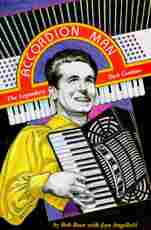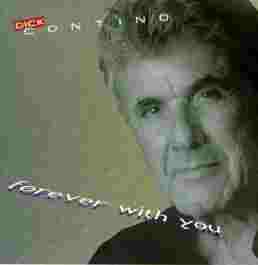The Free-Reed Review
Critiques of Compact Discs, Books and Music Scores
Dick Contino—Double Review

176 pages, 18 photographs
published in 1994 by
Review number and date: No. 67, October 1997
Father and Son Publishing
4909 N Monroe Street
Tallahassee, Florida 32303
USA
Order from: Petosa Accordions
313 NE 45th Street
Seattle, WA 98105
USA
phone: 206-632-2700
|
1) Book by Bob Bove: Accordion Man
Contents:
Prologue
- Part One
- The Young Virtuoso
- The Big Time Beckons
- Audition Time
- Horace Heidt
- Victory is His
- On the Road
- The Championship Belt
- Part Two
- Bobbysoxer Idol
- The Korean Conflict
- Blacklisted
- Dick's Better Half
- Here's Hollywood
- On the Wagon
- The Road Back
- To Russia, With Love
- Biding His Time
- At the Front
- At Peace With Himself
- The Seventies
- We'll Meet Again
- Coach Bove
- The Brown Bear
- Festa!
- Entertainment Unlimited
- Back to Chi-Town
- "Yours"
- Leigh
- Surprise!!!
- Missed You
- Epilogue
|

total time: 51:13
Released in 1996
Review number and date: No. 68 October 1997
label:
JCM Records
Order from: Petosa Accordions
313 NE 45th Street
Seattle, WA 98105
USA
phone: 206-632-2700
|
2) CD Review: Dick Contino:
Forever With You
Dick Contino, accordion and vocals
Robby Robinson, keyboards and programming
Rex Robinson, bass
Fino Roverato, guitars
Zoro, drums/percussion
Sam Riney, saxophones
Rick Baptist, trumpet/flugel horn
Todd Robinson, trombone and tuba
Diane Delin, electric violin
Time Stone and Alfie Silas, background vocals
Program:
- Ballantyne/Robinson: Tonight Is Ours
- Ballantyne/Robinson: Forever With You
- Ballantyne/Robinson: The Will to Win
- Ballantyne/Robinson: A Love Divine
- Ballantyne/Robinson: Dancing With Sunbeams
- Robinson/Contino: When Two Become One
- Ballantyne/Robinson/Contino: When We Love
- Ballantyne/Robinson/DeShannon: Pure Natural Love
- Kenny G/Afanasieff: Sentimental
- Chuck Mangione: Bellavia
- Ballantyne/DeShannon: Will You Be On My Side?
|
Review by Henry Doktorski:
What a combination!—the book Accordion Man by Bob Bove and the
compact disc Forever With You by Dick Contino go together
beautifully. During the last few hours, while reading the book I had the
CD playing along at the same time; quite a pleasurable experience.
The CD is an extremely tasteful showcase of various "light romantic" jazz
musical styles; ranging from cool jazz (Tonight Is Ours) to the Latin Beat
(The Will to Win), from disco (Dancing with Sunbeams) to light rock
(Sentimental) to blues (Will You Be On My Side). All tracks feature the
legendary artistry of Dick Contino. I was delighted that not for one
moment does the accordion detract from the other musicians; the
arrangements are interesting and feature all the performers.
I especially liked the blues guitar playing of Fino Roverato in Will
You Be On My Side and the saxophone playing of Sam Riney in
Sentimental. Although I was not impressed by Contino's singing in the
final track (fortunately this is the only song he sings) I was impressed
by his accordion playing throughout the rest of the album. He is not like
some accordion performers who get stuck in a rut and play the same style
of music for decades and decades without changing (I actually heard one
well-known aging Washington D.C. accordionist proudly boast that he hasn't
learned a new tune in thirty years!).
On the contrary, Contino has moved with the flow of contemporary music:
this album features many sounds of the pop music of the late twentieth
century, even including rather new-age techniques as the repeated motives
of the title cut: Forever With You. I would label most of the music
on this album light jazz.
But the big surprise for me was the book by Bob Bove: Accordion
Man. I could hardly put it down; it was so engaging and enjoyable.
Contino has really had an exciting (and at times depressing) life and Bove
makes no apologies for Contino's mistakes.
One cannot help but sympathize with Contino as one learns the full
unabridged story of his life. His rise to fame from 1948 to 1951 was
nothing less than phenomenal. He performed concerts from New York to
Hollywood and appeared 48 times on the Ed Sullivan television show.
Wherever he played, lines formed at the box office, lines filled with
teenage bobbysoxers who turned out in numbers that hadn't been seen since
the heyday of a skinny young crooner named Frank Sinatra. There were 500
fan clubs devoted to him throughout the United States. Contino seemed
destined to assume a place in the pantheon of America's entertainment
stars.
However in 1951 Contino's world fell apart when he was indicted as a
"draft dodger" for avoiding military service. Although he served nearly
six months in prison for refusing military service, many people did not
know that after his release from prison he served overseas for several
years in the army and was honorably discharged with the rank of Sargent
after receiving several military commendations and medals. Despite his
atonement, when he returned to show-business Contino was heckled during
performances. He began drinking and eventually gambled away a quarter of a
million dollars.
Then in the mid-1960s he got a break: he was selected to be the star of Ed
Sullivan's tour of the Soviet Union to promote cultural exchange between
the two superpowers. While in Russia, he was greeted with adoration of
such great magnitude that he hadn't seen for nearly twenty years.
The Russian people loved the accordion, and they loved Contino. He said,
"As hard as it is to admit, I welcomed the opportunity to play before
foreign audiences, to entertain people who would respect my talent and who
wouldn't hurl obscenities and vitrio my way." In fact, the Russian people
so much loved Contino that he was invited to become a Soviet citizen and a
superstar in a country that appreciated the accordion more than any
other.
Contino said, "They told me that I would never have to worry about
expenses or money or education for my children or a place to live or
status as a pre-eminent citizen. Although I was ostracized by many in
America . . . although many of the major stars, producers, showrooms, and
studios in the United States blacklisted me, I could not turn my back on
the country I loved." And so he returned the the States when the Soviet
tour was finished.
Contino's first engagement after returning home was at a small lounge in a
casino in Elko, Nevada, where he played for cowboys with sheep manure on
their boots who tossed silver dollars into slot machines, far removed from
the adoring thousands in Gorky Park, Moscow.
Today Contino is still playing throughout the United States at ethnic
festivals such as the Festa Italiana in Milwaukee. I met him in 1995 at
the Italian Festival at the IC Amphitheater in Pittsburgh. Contino said,
"as long as God gives me the ability to perform, and as long as people
keep coming to see me, I'll never retire. They'll have to carry me off the
stage!"
I have a few complaints about this book. The editing is sloppy: there are
an unusually large number of typographical errors; a line of text is
missing on page 35, a paragraph is printed twice on page 45 and a few
words are misspelled elsewhere, including the word "accordian"! (page 159)
Paying readers deserve a higher quality book and more thorough
editing.
In addition, the last half of the book seems to drag in
tempo and I was disappointed with the appendix: although Bove lists the
titles and tracks of twenty Contino albums he doesn't list the labels
or year of release, information which might make it easier for Contino
fans to find these collector's items through used record search
services.
Despite these flaws, I recommend Accordion Man for all
lovers of the accordion. You will enjoy it, and learn something about the
heyday of the instrument in the United States as well.

